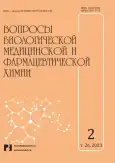Study of dosage form based on Eupatorium cannabinum herb extract wound healing activity
- 作者: Nikiforova E.B.1, Mizina P.G.2, Shevchenko A.I.1, Onbish T.E.1, Bikova O.A.3
-
隶属关系:
- Kuban State Medical University
- FSBSI All-Russian Scientific Research Institute of Medicinal and Aro-matic Plants
- FSBSI All-Russian Scientific Research Institute of Medicinal and Aromatic Plants
- 期: 卷 26, 编号 2 (2023)
- 页面: 42-46
- 栏目: Problems of experimental biology and medicine
- URL: https://journals.eco-vector.com/1560-9596/article/view/248544
- DOI: https://doi.org/10.29296/25877313-2023-02-07
- ID: 248544
如何引用文章
详细
Relevance. One of the important directions of medical science and practice remains the introduction and improvement of existing methods and means for the treatment of dermatological diseases of various etiologies. At the same time, the search for new wound-healing drugs that can comprehensively affect the wound process is relevant. Practical dermatology has an extensive range of synthetic antimicrobial, anti-inflammatory and wound healing agents. However, despite their known effectiveness, many of them are characterized by the presence of undesirable reactions for the body, such as allergies, dry skin, the formation of resistance, the development of withdrawal syndrome, a decrease in the local and general immunological response of the body. The solution of this problem can be facilitated by the use of an ointment based on a dry extract of the herb Eupatorium cannabinum L., for which, along with known antimicrobial properties, there are grounds for predicting a wound-healing effect.
The aim of the study was to study the wound-healing activity of antimicrobial ointment with a dry extract of cannabis herb in order to predict the possibility of use in medical practice as a polyvalent agent for the treatment of wound processes.
Material and methods. An ointment was developed with a dry extract of cannabis herb, the wound-healing activity of which was determined on a simulated «linear» skin wound in male rats weighing 200.0 ± 20.0 g. An assessment of the restoration of the skin in experimental groups of animals and in control was carried out.
Results. It was revealed that the restoration of the epithelium with the formed dry, pink, natural tissue and wool coating in the groups of rats treated with an experimental soft dosage form occurs earlier than in the control groups treated with a control ointment for an average of 6–8 days.
Conclusions. The results obtained allow us to recommend an ointment with an extract of the herb Eupatirum cannabinum as a means of plant origin, which has a polyvalent, including the wound-healing effect revealed in experiments.
全文:
作者简介
E. Nikiforova
Kuban State Medical University
编辑信件的主要联系方式.
Email: corpus@ksma.ru
Ph.D. (Pharm.), Associate Professor, Department of Pharmacy
俄罗斯联邦, KrasnodarP. Mizina
FSBSI All-Russian Scientific Research Institute of Medicinal and Aro-matic Plants
Email: vilarnii@mail.ru
Dr.Sc. (Pharm.), Deputy Director
俄罗斯联邦, MoscowA. Shevchenko
Kuban State Medical University
Email: anastasiyashevchenko@rambler.ru
Ph.D. (Pharm.), Associate Professor, Department of Pharmacy
俄罗斯联邦, KrasnodarT. Onbish
Kuban State Medical University
Email: corpus@ksma.ru
Ph.D. (Pharm.), Associate Professor, Department of Mobilization Training of Health Care and Medical Disaster
俄罗斯联邦, KrasnodarO. Bikova
FSBSI All-Russian Scientific Research Institute of Medicinal and Aromatic Plants
Email: orpus@ksma.ru
Ph.D. (Biol.), Director of the North Caucasian branch
俄罗斯联邦, Moscow参考
- Konakova A.V., Kushakova K.A. Gormonal'nye mazi dlja lechenija kozhnyh zabolevanij. Innovacii. Nauka. Obrazovanie. 2021; 28: 1314–1320.
- Sampiev A.M., Nikiforova E.B., Shevchenko A.I. Metodologicheskij podhod k vyjavleniju dejstvujushhih veshhestv v rastitel'nyh ob’ektah. Aktual'nye voprosy sovremennoj farmacevticheskoj tehnologii: materialy Vserossijskoj nauchno-prakticheskoj konferencii s mezhdunarodnym uchastiem. 2016; 133–145.
- Mel'nikova O.A., Samkova I.A. Analiz farmacevticheskogo rynka protivoozhogovyh lekarstvennyh preparatov dlja naruzhnogo primenenija Rossijskoj Federacii. Nauchnye vedomosti. 2016; 12: 150–158.
- Sambukova T.V., Ovchinnikov B.V., Ganapol'skij V.P. i dr. Perspektivy ispol'zovanija fitopreparatov v sovremennoj farmakologii. Obzory po klinicheskoj farmakologii i lekarstvennoj terapii. 2017; 15(2): 56–63.
- Wang X., Ma S., Lai F., Wang Y., Lou C. Traditional applications, phytochemistry, and pharmacological activities of eupatorium lindleyanum. Comprehensive Review. Front Pharmacol. 2020; 8: 1–22.
- Shevchenko A.I., Sampiev A.M. Aminokislotnyj i mineral'nyj sostav travy poskonnika konopljanogo. Izvestija vysshih uchebnyh zavedenij. Severo-Kavkazskij region. Serija: Estestvennye nauki. 2007; 4(140): 92–93.
- Shevchenko A.I., Sampiev A.M. Razrabotka sostava i issledovanie antimikrobnoj aktivnosti mazi s jekstraktom poskonnika. Nauka Kubani. 2012; 4: 25–28.
- Habriev R.U. Rukovodstvo po jeksperimental'nomu (doklinicheskomu) izucheniju novyh farmakologicheskih veshhestv. M.: Medicina, 2013: s. 942.
- Bokov D.A., Mihajlov N.O. Sravnitel'nyj analiz sovremennyh metodik izmerenija ploshhadi ranevoj poverhnosti. Molodezhnyj innovacionnyj vestnik. 2022; 11(2): 27–31.






